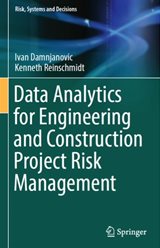Houston – Book Presentation Data Analytics for Engineering and Construction Project Risk Management
27 August, 2020
Risk management is an integral part of engineering design and construction project management. However, the practices widely vary in their level of sophistication across different companies and industry segments, from purely qualitative methods based on subjective scoring to more analytical simulation methods. The emphasis of the book “Data Analytics for Engineering and Construction Project Risk Management” and this presentation is given to data-driven risk models, and these models are of necessity mathematically inspired.
As the British physicist William Thomson (Lord Kelvin) said (1883) “when you cannot measure it, when you cannot express it in numbers, your knowledge is of a meager and unsatisfactory kind;” and “meager and unsatisfactory” is a good description of practices in many engineering and construction projects. It may be argued that project managers should place their confidence in experience, judgment, and gut feel, not mathematics. However, learning about risk by the trial-and-error method can take a long time and the lessons can prove to be very expensive. Therefore, the key message is that model building should be informed by, and consistent with, judgment and experience, but any model beats no model 9 times out of 10.

This book provides a step-by-step guidance on how to implement analytical methods in project risk management. The text focuses on engineering design and construction projects and as such is suitable for graduate students in engineering, construction, or project management, as well as practitioners aiming to develop, improve, and/or simplify corporate project management processes.
The book places emphasis on building data-driven models for additive-incremental risks, where data can be collected on project sites, assembled from queries of corporate databases, and/or generated using procedures for eliciting experts’ judgments. While the presented models are mathematically inspired, they are nothing beyond what an engineering graduate is expected to know: some algebra, a little calculus, a little statistics, and, especially, undergraduate-level understanding of the probability theory.
The book is organized in three parts and fourteen chapters. In Part I the authors provide the general introduction to risk and uncertainty analysis applied to engineering construction projects. The basic formulations and the methods for risk assessment used during project planning phase are discussed in Part II, while in Part III the authors present the methods for monitoring and (re)assessment of risks during project execution.
Book orders
Book orders must be placed before July 27th to get your soft copy signed by the author and delivered to your home/office. Books are shipped by Springer Nature in New York. Book cost provided by SUT-US already includes tax and shipping for U.S. based participants. If you are based outside of the U.S., you will need to pay for shipping costs.
For any inquiries regarding book orders, click here to contact us.
About the authors
 Dr. Ivan Damnjanovic, Associate Professor Civil & Environmental Engineering, Texas A&M University
Dr. Ivan Damnjanovic, Associate Professor Civil & Environmental Engineering, Texas A&M University
Ivan D. Damnjanovic is an Associate Professor, J.L. “Corky” Frank/Marathon Ashland Petroleum LLC Faculty Fellow, and the Director of Engineering Project Management program at Texas A&M University. He is also the Founder of Riskopedia Analytics consultancy. Dr. Damnjanovic specializes in qualitative and quantitative methods for assessment and management of engineering and project risks. He has an extensive experience in risk and safety analysis applied to projects from different industry segments including transportation infrastructure, oil&gas, and technology development. Dr. Damnjanovic has been a lead investigator on more than 20 state and federally funded studies, and the author of more than 50 peer reviewed journal publications and reports. He has served as a member of a number of committees that looked into industry-wide applications of risk analysis. At Texas A&M University Dr. Damnjanovic teaches project risk management and project finance and has earned awards for his instruction.
 Dr. Kenneth Frank Reinschmidt, (March 26, 1938 – December 31, 2018)
Dr. Kenneth Frank Reinschmidt, (March 26, 1938 – December 31, 2018)
Ken was a military veteran, dedicated public servant, industry visionary, and brilliant researcher and engineer. Over his long and esteemed career, Ken achieved excellence in all areas he pursued. He entered military active duty in January 1966, while on a leave of absence from MIT, and led the team development of an integrated computer-based system for planning and management of military operations. He was honorably discharged, in December 1967, at the rank of captain. Further dedicating his energy to the public, he chaired multiple National Research Council committees and initiatives, provided testimony to Congress on Electric Power System Reliability, and served on numerous other committees. During his time working in industry, Ken raised through the ranks to be become the Elected President and Chief Executive Officer of Stone & Webster Advanced Systems Development Services, Inc. and through that work he impacted the nuclear industry as a whole. Finally, in academia, as a professor at both MIT and TAMU, Ken was fundamental in developing of what is now known as Building Information Modeling (BIM), use of Artificial Intelligence and expert systems in engineering and construction, and implementation of advanced computing methods to project management. His contributions have been acknowledged by his peers, culminating in 1991, in which Ken was elected to the National Academy of Engineering and became a Fellow of the American Association for the Advancement of Science.